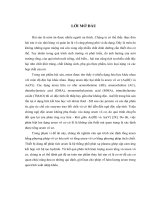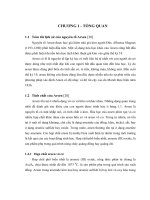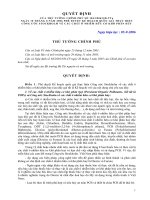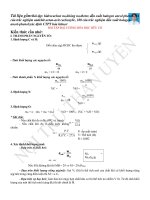Nano huu co FINISH
Bạn đang xem bản rút gọn của tài liệu. Xem và tải ngay bản đầy đủ của tài liệu tại đây (2.15 MB, 50 trang )
Ho Chi Minh City University of Technology
Chemical Engineering
Polymeric nanoparticles for oral drug delivery
Advisor
: Dr. Le Thi Hong Nhan
Postgraduate Student: Huynh Kim Ngan
Nguyen Thi Kim Hang
Nguyen Hoai Thuong
4/20/16
Le Thi Bich Phuong
1
ROUTES OF DRUG ADMINISTRATION
Oral Drug System
Advantages
Safes
Most convenient
Most economical
Disadvantages
Poorly absorption of large
Highly charged molecules
Degradation of drug by stomach acid
Parenteral Administration
Intramuscular
Patient can administer the drug himself
Larger volume than subcutaneous
By-pass first pass metabolism
Invasive – patient disconfort
Irritation, inflamation
May require some training
Transdermal administration
• Advantages
Solution for drug that can not be administered by
oral delivery
Reliability, precision of dosage
• Disadvantages
Discomfort
Possibility of infection
Tissue damage
Global drug delivery market by administration mode
Oral Delivery
(Gastrointestinal Administration)
Gastrointestinal Administration
Gastrointestinal Administration
Saliva?
pH = 5.5 – 7
Oral cavity : water rich environment
selection of hydrophylic matrices as
drug carriers
Dosage forms
Liquid
Dispersed system
Solids
Controlled Release
Targeted Delivery
Nanoparticle for Drug Delivery System
Polynmeric Drug delivery system
Prodrug
Prodrug
Prodrug = Drug + Drug delivery system
Types of Prodrugs
Comparison oral drug delivery and oral nanoparticles delivery
4/20/16
18
6
5
4
•
Dosage Form
3
•
Dose
2
•
Drug Release
1
•
•
Freeze-Drying
Nanoparticle formulation
Stabilizers for NPs
Materials for Preparing NP Matrix
Polymers
Natural polymers
4/20/16
Synthetic polymers
19
Natural polymers
Advantages
- Low cost.
- Biocompatibility.
- Aqueous solubility.
Disadvantages
- The presence of impurities.
- Batch-to-batch varibility.
- Low hydrophobicity.
4/20/16
20
Synthetic polymers
Advantages
- More reproducible.
- Degradation rates.
- Molecular weights.
- Copolymer compositions.
Disadvantages
- Limited solubility.
- Soluble only in organic solvents.
4/20/16
21
Natural polymers
•
•
These are the polymers obtained from natural resources and are generally non-toxic.
Natural polymers are formed in nature during the growth cycles of all organisms.
Proteins
Natural polymers
Collagen
Agarose
Albumin
Alginate
Gelatin
Carraheenan
Polysaccharides
Hyaluronic acid
Dextran
Chitosan
4/20/16
Cyclodextrins
22
Synthetic polymers
Poly(lactic acid) (PLA)
Polyesters
Poly(glycolic acid) (PGA)
Poly(hydroxy butyrate)
Synthetic polymers
Polycaprolactone (PCL)
Polyanhydrides
Poly(adipic acid)
4/20/16
23
Miscellaneous
Stearic acid and
Gliadins.
Hydroxypropyl methyl
cellulose phthalate.
NPs are also prepared
by utilizing simple organic or
inorganic compounds.
4/20/16
24
Stabilizers for NPs
Stabilizers are used to
prevent the aggregation of
particles by conferring a
surface charge.
The higher the surface
charge the greater is the
stability.
4/20/16
25









